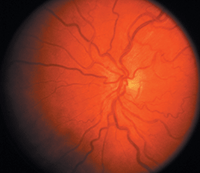I often get questions regarding coding and compliance issues for clinical situations in which a systemic disease may have ocular sequelae. Sometimes there are ocular signs and symptoms related to the systemic disease, while other times there is no sign or symptom of ocular involvement, although we know the systemic condition may eventually affect the eye.
 |
While many systemic conditions pose a risk of ocular problems, much of the supplementary ophthalmic testing is not considered medically necessary or appropriate until the patient reports symptoms or the physician observes a clinical sign. This key point is often ignored in everyday practice. Keep in mind that we generally do not get paid to document a normal ocular state even in the presence of systemic disease—unless there is a clinical sign or a symptom present.
While personally I agree with the argument that special testing—such as optical coherence tomography/digital imaging of the retina, macular pigment optical density, visual fields, electroretinography, visual evoked potential, etc.—allows you to detect ocular disease or the potential for ocular disease, the reality is that third-party carrier rules do not provide for prognostic testing.
For example, a patient could have diabetes, but presents with no symptoms and the examination reveals no diabetic ocular changes. You may argue that if you were to take a fundus photograph, you could see things that you couldn’t see with your traditional ophthalmoscopic examination. However, this type of testing would be prognostic, and not based upon the clinical signs and symptoms currently present.
Of course, you can still offer the test to the patient as an out-of-pocket expense if you think that prognostic aspect is important. But the carrier won’t be responsible even if you have a systemic diagnosis that provides you with a covered diagnosis for the CPT code relationship.
Keep in mind that the relationship, or mapping, of a diagnosis code to a CPT code still requires the physician to meet the definition of medical necessity in which clinical signs and symptoms are present. Simply having a covered diagnosis “mapped” to a CPT code isn’t enough to meet standard coding requirements.
Systematic Coding
If you do meet this requirement, the ICD rules are fairly straightforward regarding the coding sequence of the diagnosis—systemic first, then any ocular complications or sequelae.
So, if we consider our diabetic patient, you would want to stipulate the specific type of systemic diabetes that patient has as the primary diagnosis, and then identify the ocular manifestations hierarchically after that. This is true for the current ICD-9 system that we use now and will hold true for the ICD-10 system scheduled for implementation on October 1, 2015.

|
|
| If a patient presents with no signs or symptoms, third-party carriers likely won't cover further testing. Photo: Mark T. Dunbar, OD |
One thing to note for ICD-10: You’ll need to have more detailed and more frequent communication with the primary care doctor to make sure that the specific systemic diagnoses match between your claim form and the PCP’s records.
Optometric involvement in systemic disease management is a growing part of contemporary practice. Just look at optometry’s growing involvement with diabetes care, as an example.
So, understanding the relationship between the disease, the ocular manifestations and the requirements for your medical record are all important issues that you must be aware of, and for which you must establish protocols in your practice.
Please send your questions and comments to [email protected].

